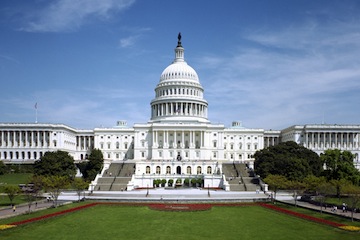The Bicameral Legislature and the U.S. Constitution
 Both houses of Congress meet in the United States Capitol
Both houses of Congress meet in the United States Capitol
Article One of the U.S. Constitution established the basic structure of the legislative branch of government. This branch contains a House of Representatives and a Senate. At various times one or both these branches have been accused of being out of touch the popular will of the public. In the early 21st century we have calls for reform of the House of Representatives in particular. Given these complaints, why was the legislative branch set up with two houses in the first place? To answer this, let us look to the Constitutional Convention itself, and to the subsequent writings of James Madison.
Like most of the Constitution, Article One was the result of a compromise between various proposals from different delegates. One group, advocating the Virginia Plan, desired a legislature with more members from the larger states. Another group, advocating the New Jersey Plan, desired a legislature with one member from each state. Obviously, since Virginia was a large state, and New Jersey a small state, there was some level of self-interest in these proposals. After weeks of debate the delegates reached what is known as the Connecticut Compromise. One house of the legislature (the House of Representatives) would be elected by the people and would grant more members to the larger states. The other house (the Senate) would be elected by state legislature and would consist of two members from each state. Thus, the legislature would be bicameral and the resulting Constitution could win support from both the smaller and larger states of the nation.
Besides this expediency, there were good practical arguments put forward for the division of the legislature into two branches. The government as a whole is founded on a system of checks and balances, where each branch can overrule the actions of other branches. But in the case of the legislature, the bicameral system goes further and creates checks and balances between the Senate and the House. This was no accident. James Madison defended it as a conscious design in the Federalist Papers while arguing for the ratification of the Constitution. In Federalist No. 51 he wrote, "In republican government, the legislative authority necessarily predominates. The remedy for this inconveniency is to divide the legislature into different branches; and to render them, by different modes of election and different principles of action, as little connected with each other as the nature of their common functions and their common dependence on the society will admit."
In other words, Madison did not want the two branches to march in lockstep with each other, but to have differences of opinion and political composition. At the end of the legislative process, a law should only pass if the desire for it is so overwhelming as to overcome of objections of two branches and most of the members thereof. In Federalist No. 62 he wrote, "In this point of view, a senate, as a second branch of the legislative assembly, distinct from, and dividing the power with, a first, must be in all cases a salutary check on the government. It doubles the security to the people, by requiring the concurrence of two distinct bodies in schemes of usurpation or perfidy, where the ambition or corruption of one, would otherwise be sufficient."
The New Deal demonstrates this principle most clearly. In the midst of the Great Depression, the public will in support of liberal programs was so strong that overwhelming Democratic majorities were elected to both houses of Congress. These huge majorities then voted in favor of Franklin Roosevelt's agenda (for the most part) and altered the nature of U.S. government ever since. Every Constitutional Amendment thus far has also been passed with at least two-thirds support from both houses of Congress.
One person's "badly needed reform" is another's "scheme of usurpation and perfidy", to borrow a phrase from Madison. Many Presidents besides Roosevelt have wished for the same cooperation from Congress. However, in cases where the two parties are closely matched in numbers, the bias of the Constitution is for inaction. Thus, there were Harry Truman's complaints about the "Do Nothing Congress" of 1947-48. Or more recently, the inability of George W. Bush to pass social security or immigration reform, or for Barack Obama to implement the "public option" in the Affordable Care Act or to pass the cap and trade bill that he dearly wanted. Conversely, once passed a law is difficult to repeal. Although the Republicans regained a majority after the Affordable Care Act was passed, they were unable to repeal it. Although such incidents have proven frustrating to many, they are the direct result of how the Constitution was written by its framers.